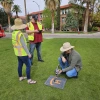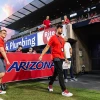Making the World a Better Place with IT in the College of Engineering
A discovery series on the diversity and uniqueness of technology services at Arizona.

Information technology support in the College of Engineering focuses on a myriad of unique research and academic technologies. Every day brings a new challenge to Leo Enfield, Information Technology Manager, Principal, and his information technologies team known as ENGR-IT. The College of Engineering – with over 4,000 students and approximately 700 faculty, staff and students on payroll – includes 17 undergraduate majors and 15 graduate degree programs across ten departments.
With an abundance of technical research – the college’s research expenditures increased 19% to $63 million in 2023 – and emerging technologies, the work of a College of Engineering IT technician could easily become overwhelming.
Leo has a team of seven additional IT staff and usually about three student workers who support the vast teaching, research, student and administrative needs for the Departments of Aerospace and Mechanical Engineering, Biomedical Engineering, Chemical and Environmental Engineering, Civil and Architectural Engineering and Mechanics, Electrical and Computer Engineering, Materials Science and Engineering, Mining and Geological Engineering, Optical Sciences and Engineering, and Systems and Industrial Engineering. He admits that every day his team learns something new.
“We get into spaces where we’re not familiar with what we need to do, and we have to learn at the same time to make sure we can support the research and academic teams,” Leo says.
Autonomous Vehicle Technologies
Leo’s team provides skilled tech support for the ECE department’s new self-driving vehicle. Loukas Lazos, professor of ECE, tasked John Masterson and David Armenta – who manage the Linux system for ENGR-IT – to set up a learning environment where student groups can access their own working model of a self-driving vehicle system.
“The operating system for the vehicle is Linux-based,” Leo says. “We need to come up with a way to modularize that operating system, create a backup of it, then build an environment where they can implement different scenarios or simulations for this system for use by different groups that might be working with it.”
Wind Tunnel Technologies
Another project with a learning curve for Leo’s team was provided by Vitaliy Yurkiv, assistant professor of AME. AME has several wind tunnels for research and education. The environment hosts hypersonic aviation research, which requires fast camera footage to capture activity in the wind tunnels.
“To capture information, the cameras need to be fast, and so does the network researchers use to manage the camera,” Leo explains.
Leo’s team is working on increasing network capacity in this internal environment by connecting four cameras at the required 25 Gbps per second throughput. He said this project is a great example of finding the balance that is necessary for emerging technology research and staying within the framework of the standard University network.
“We’ve always been good partners with UITS in creating this balance where we can effectively help researchers get their work done while meeting security requirements that are critical to the University network environment,” Leo adds.
San Xavier Underground Mine Technologies
Leo and his staff have partnered with UITS to bring the University IP space out to an actively working mine used for learning and research opportunities. The San Xavier Underground Mining laboratory is the only student-run multilevel mine in the United States with a working vertical shaft.
Located 15 miles south of Tucson, it includes a classroom environment and an active mining site “where student researchers work with industry partners to develop innovative best practices for responsible production and sustained reuse of mineral resources. MGE students are driving new domestic approaches to sustainability.”
Jesse Stengel, who handles many of the varied network requests for ENGR-IT, established the IP network to the classroom and partnered with another company specialized in networking mining infrastructure and tools to support the work inside the mine.
“The mine has a Wi-Fi network that is part of the University’s multidisciplinary Mine Health and Safety program,” Leo says. “The mine systems have a lot of sensing of both seismic activity and atmospheric condition. The system provides a means of tracking miners and equipment underground.”
Leo is called in when connectivity is lost somewhere within the mine, and he lends a hand in troubleshooting and re-establishing network service.
Chip Fabrication Technologies
The University’s Micro/Nano Fabrication Center recently received a $35.5 million grant from the Arizona Commerce Authority to upgrade and expand the campus facility in partnership with Northern Arizona State University. The plan for boosting Arizona’s semiconductor industry directly impacts the research and training efforts of the ECE department.
Leo says a critical piece of chip fabrication includes the need for ultra-pure water during the manufacturing process. “We have a lot of excess water that is still useable, Dr. Kevin E. Lancey, professor in CAEM, is working on redirecting that extra water rather than returning it to Tucson Water processing plants.”
They plan to divert the excess water to irrigate plants around the ECE and the civil engineering buildings and study the impact of the diversion on the environment in the area. As with many engineering projects, collection of data is a key part of this successful research. The ENGR-IT team has been called upon to assist in establishing connectivity for data collection.
There are many unique, program-specific technologies for Leo and his IT team to build and support, with the shared goal of teaching tomorrow’s engineers and researchers. Zac Chapman manages the support of 12 instructional classrooms that are not part of the University centrally-managed Classroom Technology Services and is frequently called when there are college or community events held in one of the many locations across campus. Perhaps one of the most visible college events that require robust IT support throughout the year is the Craig M. Berge Engineering Design Day, where engineering seniors present their projects to industry judges and the community.
There are also dozens of engineering student clubs that Leo’s team supports, from the Rube Golberg Club and Wildcat Formula Racing, to Arizona Autonomous Vehicles Club and the Student Optics Chapter.
Leo shares this last thought. “Our team members know that their individual contributions are not just closing a support ticket, but, in a small way, every day, we’ve helped U of A Engineers to build things that help to make the world a better place.”










